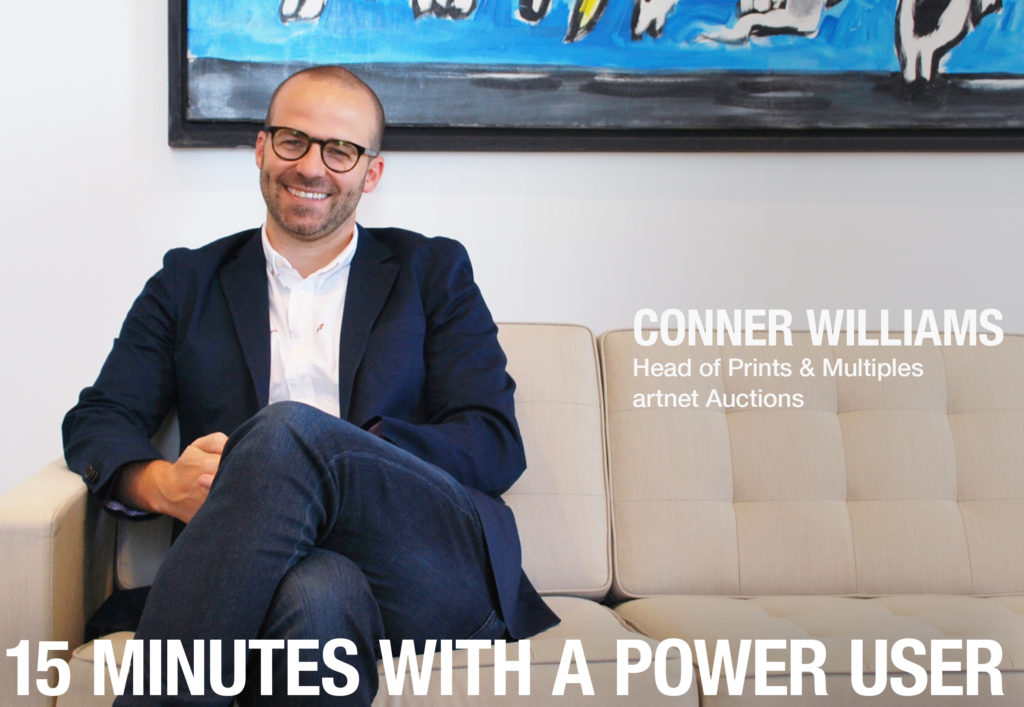15 Minutes With a Power User: Conner Williams


Artnet Price Database Team

There is only one tool trusted by art-world insiders to buy, sell, and research art: the artnet Price Database. Its users across industries—from auction houses to museums, galleries and government institutions—represent the art world’s most important players. We’re taking 15 minutes to chat with some of the artnet Price Database’s power users to get their take on the current state of the market and how they’re keeping up with the latest trends.
In advance of California Cool, an auction featuring works by quintessential West Coast artists currently live for bidding on artnet Auctions, we caught up with Conner Williams, Head of Prints and Multiples. With over 10 years of experience in the field, he’s seen the auction market from many angles, having previously worked at Christie’s and Sotheby’s in the prints and postwar and contemporary departments.
Now, as a specialist at the world’s most dynamic online auctions platform, he knows firsthand how fast the market moves and how good information is the best way to stay ahead of it. We spoke with Conner about the growing importance of prints in the auction world at large and what buyers should know about this exciting collecting category.
How have you seen the prints market change over the last five years?
Great question, and one that I’m always trying to answer in order to determine how we can best position ourselves going forward. The influx of new clients fascinates me, and exactly who these clients are and how they come into the market never ceases to amaze me.
For some, spending $3,000 on a print is a lot of money, and helping them learn about a work prior to a purchase is really fulfilling. At the same time, the average price point in our Prints & Multiples auctions is nearly $15,000, and in two short years our sales have doubled, with our Prints sales in the first half of 2019 realizing nearly $6 million. What this tells me is that the market is as vast and accommodating as we can imagine, and clients are comfortable buying online. I anticipate that this growth will continue for prints, online and elsewhere, and not simply in a seasonal manner that is the major auctions and fairs.
What about prints makes them so sell-able online?
I used to think it was price point, and the nice entry level that prints offer for new buyers. This is an oft-repeated, marketed notion and while very true, I’ve come to learn that there’s a more telling, interesting answer: there is a general level of comfort and confidence in clients with editioned work.
Clients know what to expect in terms of commonly associated condition issues and fair market value with prints, which is a quick search away in our Price Database. Clients already have tools at their fingertips to help them learn and grow in the market and, I believe, they have also come to realize that buying online just isn’t that scary, especially when there’s very a knowledgeable and experienced specialist on the other end.
Mehretu is an extremely talented artist whose work translates well in print and one who I think has been very wise about how many prints she produces to satisfy demand.
What artists’ prints markets do you see taking off in the next 12 months?
Last summer, I visited the printer-publisher Gemini G.E.L. in Los Angeles. They were completing several large intaglio prints by Julie Mehretu, which have since been released and shown at this year’s Art Basel. Nearly all sold out with some release prices reaching well over $100,000. Let me repeat that: the release price for a print was over $100,000.
I can’t recall a print with such a high release price being sold out so quickly. For some perspective, Andy Warhol‘s Myths portfolio, a complete set of 10 screenprints, was released in 1981 for around $15,000—the set now brings over $500,000 at auction. Roy Lichtenstein‘s Nude With Blue Hair was released by Tyler Graphics in 1994 for $7,500 and now trades for over $500,000 as well.
Mehretu is an extremely talented artist whose work translates well in print and one who I think has been very wise about how many prints she produces to satisfy demand.
What is a lot that surprised you, in terms of how much or how little it sold for?

Andy Warhol, Orangutan (from Endangered Species), 1983. © 2019 The Andy Warhol Foundation for the Visual Arts, Inc. / Artists Rights Society (ARS), New York
What do you personally collect?
I grew up in California and have been in New York for over 15 years now. California, like it does for many New Yorkers, has this strange and other worldly appeal, but for me it’s largely nostalgic. Wayne Thiebaud is a favorite, and I have collected several prints by him over the years. The colors in his prints and many of his subjects, especially the landscapes, speak directly to my childhood in the Central Valley, not far from where he makes his residence. I’ve also collected prints by Bruce Nauman, Louise Bourgeois, Richard Bosman, John Baldessari, Ed Ruscha, Helen Frankenthaler, Richard Serra, Claes Oldenburg, Sol LeWitt, and Alex Israel. There’s no overarching theme to what I’ve decided to collect. Some are funny, playful, even subversive and disturbing (thank you, Mr. Nauman and Mr. Bosman) and others simply spectacular to see and enjoy everyday.
Just as important and as fun as collecting prints has been, I’ve also sought out prints produced by certain publishers, many California based, including Crown Point Press, Hamilton Press, Mixografia, Art + Culture, Cirrus Editions and Gemini G.E.L., to name a few. As publishers are truly the primary market for prints, I’ve made a keen effort to support them by introducing them to collectors. After all, there simply wouldn’t be Prints & Multiples auctions without them.
Why should collectors today use artnet Auctions for buying or consigning?
Having been at artnet Auctions for nearly six years, which operates in the digital sphere and not the traditional brick-and-mortar, I’ve become more and more aware of how the larger art world, not simply auctions, transacts. People want to buy and sell art whenever is convenient and easiest for them—beyond the parameters of seasonal auctions and fairs.
We offer several auctions a month in three categories: Prints & Multiples, Photographs, and Contemporary Art. The turnaround to sell with us can be days and not months. Our costs are considerably lower on the sell side and clients don’t need to pay out-of-pocket costs to ship or insure works in advance of a sale. On the buy side, clients can register, bid, and buy within minutes and be connected with a trusted specialist in the same time.
As such, what we offer clients looking to buy and sell—at auction or privately—isn’t simply the future but the present, and I only see growing confidence in our business and the online space.
What is the last thing you searched for on the Price Database?
Vija Celmins. There’s been a noticeable rise in the artist’s print market in the last two years and as a result, clients have come forward with interest in selling (and buying).
The timing of her market is no coincidence, as is often the case in the art world. Matthew Marks Gallery showed a selection of new work by her in 2017—her first show in seven years—with the show selling out quickly, including the newest prints. This also anticipated a major retrospective of her work at SFMOMA in 2018, which will travel to the Met Breuer later this year.
The Price Database is the art market research tool trusted by appraisers and aspiring collectors alike. To learn more and to choose from our range of subscription options, click here.